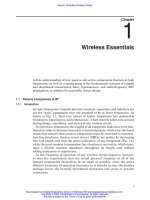Chapter1 b
Bạn đang xem bản rút gọn của tài liệu. Xem và tải ngay bản đầy đủ của tài liệu tại đây (247.77 KB, 19 trang )
Protocol “Layers”
Networks are complex!
many “pieces”:
hosts
routers
links of various media
applications
protocols
hardware, software
Question:
Is there any hope of organizing
structure of network?
Or at least our discussion of
networks?
1: Introduction
1
Organization of air travel
ticket (purchase)
ticket (complain)
baggage (check)
baggage (claim)
gates (load)
gates (unload)
runway takeoff
runway landing
airplane routing
airplane routing
airplane routing
a series of steps
1: Introduction
2
Organization of air travel: a different view
ticket (purchase)
ticket (complain)
baggage (check)
baggage (claim)
gates (load)
gates (unload)
runway takeoff
runway landing
airplane routing
airplane routing
airplane routing
Layers: each layer implements a service
via its own internal-layer actions
relying on services provided by layer below
1: Introduction
3
Layered air travel: services
Counter-to-counter delivery of person+bags
baggage-claim-to-baggage-claim delivery
people transfer: loading gate to arrival gate
runway-to-runway delivery of plane
airplane routing from source to destination
1: Introduction
4
ticket (purchase)
ticket (complain)
baggage (check)
baggage (claim)
gates (load)
gates (unload)
runway takeoff
runway landing
airplane routing
airplane routing
arriving airport
Departing airport
Distributed implementation of layer functionality
intermediate air traffic sites
airplane routing
airplane routing
airplane routing
1: Introduction
5
Next example
Chuyển thông điệp
“I lov u” cho TH
Trại
giam
T16
Luton,
Anh
quốc
Mai
Phương
Thị
HuyềnTiến
thứ trưởng gửi cô
thông điệp “I lov u”
From : Tiến thứ trưởng,
Trại giam T16
To : Hoa hậu MP, Luton
“I lov u”
Bưu cục Hà Tây
Bưu cục Hà Nội
Bưu cục Luton
Bưu cục London
1: Introduction
6
Why layering?
Dealing with complex systems:
explicit structure allows identification, relationship of complex
system’s pieces
layered reference model for discussion
modularization eases maintenance, updating of system
change of implementation of layer’s service transparent to rest
of system
e.g., change in gate procedure doesn’t affect rest of system
layering considered harmful?
1: Introduction
7
Internet protocol stack
application: supporting network applications
ftp, smtp, http
transport: process-to-process data transfer
tcp, udp
network: routing of datagrams from source to
destination
ip, routing protocols
link: data transfer between neighboring
network elements
ppp, ethernet
application
transport
network
link
physical
physical: bits “on the wire”
1: Introduction
8
Layering: logical communication
Each layer:
distributed
“entities” implement
layer functions at
each node
entities perform
actions, exchange
messages with peers
application
transport
network
link
physical
application
transport
network
link
physical
network
link
physical
application
transport
network
link
physical
application
transport
network
link
physical
1: Introduction
9
Layering: logical communication
E.g.: transport
take data from app
add addressing,
reliability check info to
form “datagram”
send datagram to peer
wait for peer to ack
receipt
analogy: post office
data
application
transport
transport
network
link
physical
application
transport
network
link
physical
ack
data
application
transport
network
link
physical
network
link
physical
data
application
transport
transport
network
link
physical
1: Introduction
10
Layering: physical communication
data
application
transport
network
link
physical
application
transport
network
link
physical
network
link
physical
application
transport
network
link
physical
data
application
transport
network
link
physical
1: Introduction
11
Protocol layering and data
Each layer takes data from above
adds header information to create new data unit
passes new data unit to layer below
M
Ht
M
Hn Ht
Hl Hn Ht
M
M
source
destination
application
transport
network
link
physical
application
transport
network
link
physical
M
message
Ht
M
segment
Hn Ht
Hl Hn Ht
M
M
datagram
frame
1: Introduction
12
Internet structure: network of networks
roughly hierarchical
national/international backbone
local
ISP
providers (NBPs)
e.g. BBN/GTE, Sprint, AT&T, IBM,
UUNet
interconnect (peer) with each other
privately, or at public Network Access
Point (NAPs)
regional ISPs
connect into NBPs
local ISP, company
connect into regional ISPs
regional ISP
NBP B
NAP
NAP
NBP A
regional ISP
local
ISP
1: Introduction
13
National Backbone Provider
e.g. BBN/GTE US backbone network
1: Introduction
14
Internet History
1961-1972: Early packet-switching principles
1961: Kleinrock - queueing theory
shows effectiveness of packetswitching
1964: Baran - packet-switching in
military nets
1967: ARPAnet conceived by
Advanced Reearch Projects Agency
1969: first ARPAnet node
operational
1972:
ARPAnet demonstrated
publicly
NCP (Network Control
Protocol) first host-host protocol
first e-mail program
ARPAnet has 15 nodes
1: Introduction
15
Internet History
1972-1980: Internetworking, new and proprietary nets
1970: ALOHAnet satellite network in
Hawaii
1973: Metcalfe’s PhD thesis proposes
Ethernet
1974: Cerf and Kahn - architecture for
interconnecting networks
late70’s: proprietary architectures:
DECnet, SNA, XNA
late 70’s: switching fixed length packets
(ATM precursor)
1979: ARPAnet has 200 nodes
Cerf and Kahn’s internetworking
principles:
minimalism, autonomy - no
internal changes required to
interconnect networks
best effort service model
stateless routers
decentralized control
define today’s Internet architecture
1: Introduction
16
Internet History
1980-1990: new protocols, a proliferation of networks
1983: deployment of TCP/IP
1982: smtp e-mail protocol
defined
1983: DNS defined for nameto-IP-address translation
1985: ftp protocol defined
1988: TCP congestion control
new national networks: Csnet,
BITnet, NSFnet, Minitel
100,000 hosts connected to
confederation of networks
1: Introduction
17
Internet History
1990’s: commercialization, the WWW
Early 1990’s: ARPAnet decomissioned
1991: NSF lifts restrictions on
commercial use of NSFnet
(decommissioned, 1995)
early 1990s: WWW
hypertext [Bush 1945, Nelson
1960’s]
HTML, http: Berners-Lee
1994: Mosaic, later Netscape
late 1990’s: commercialization of
Late 1990’s:
est. 50 million computers on
Internet
est. 100 million+ users
backbone links runnning at 1
Gbps
the WWW
1: Introduction
18
Chapter 1: Summary
Covered a “ton” of material!
Internet overview
what’s a protocol?
network edge, core, access
network
performance: loss, delay
layering and service models
backbones, NAPs, ISPs
history
ATM network
You now hopefully have:
context, overview, “feel” of
networking
more depth, detail later in
course
1: Introduction
19









